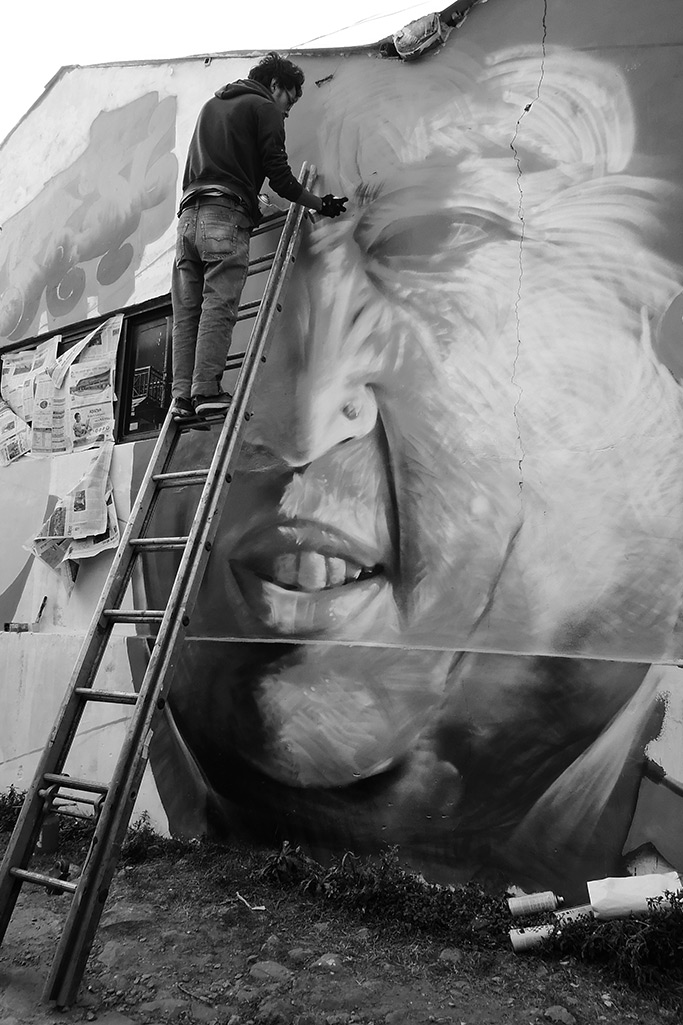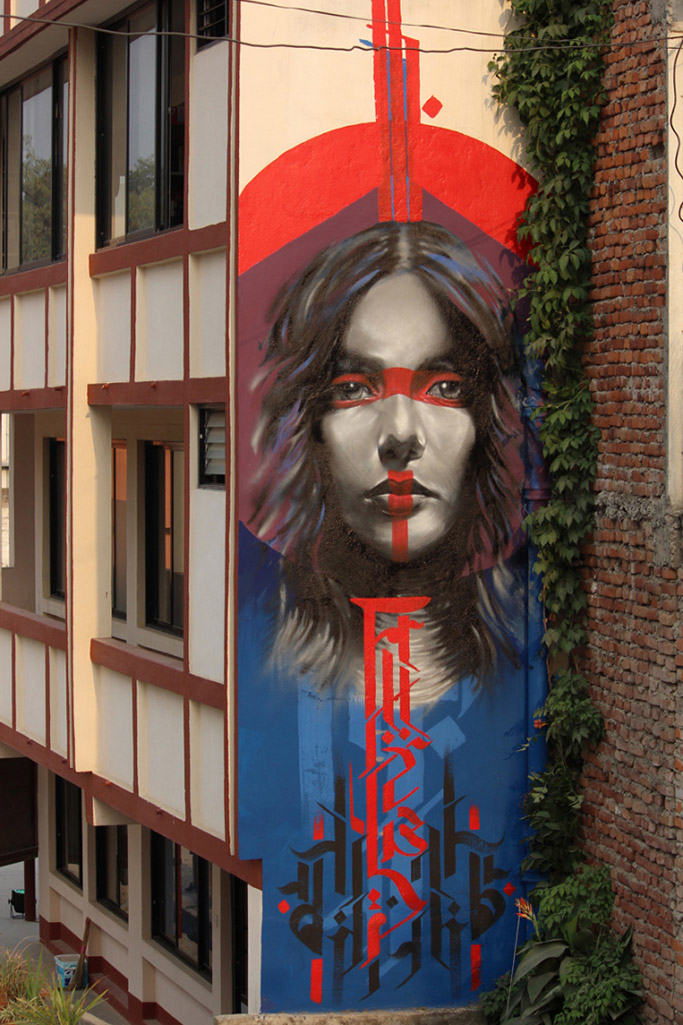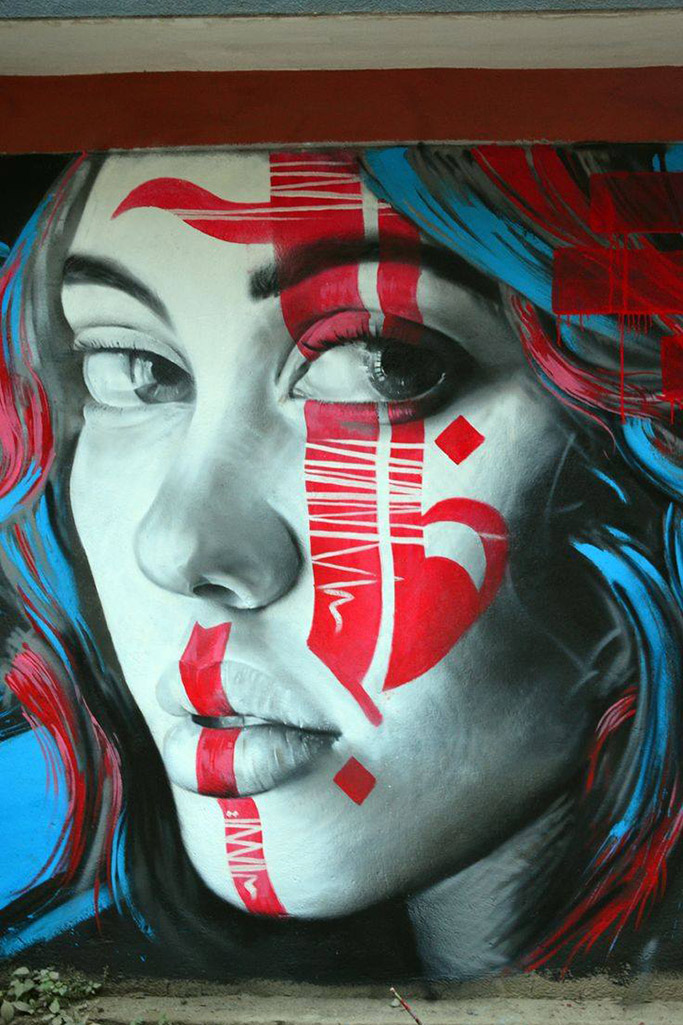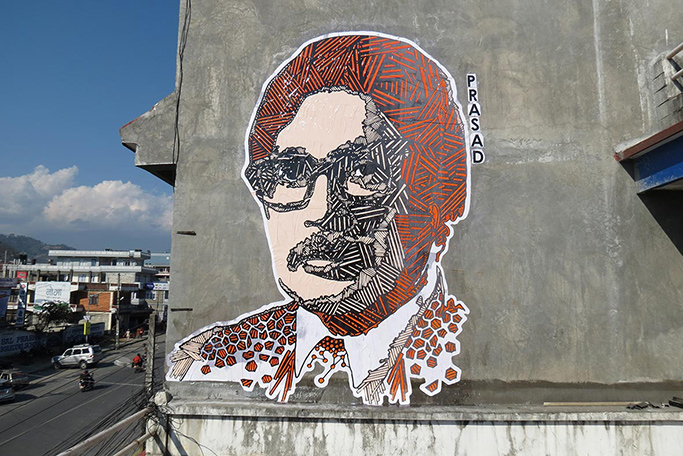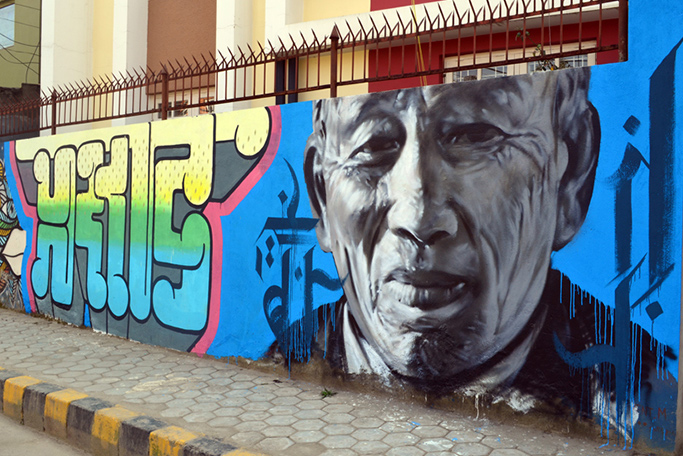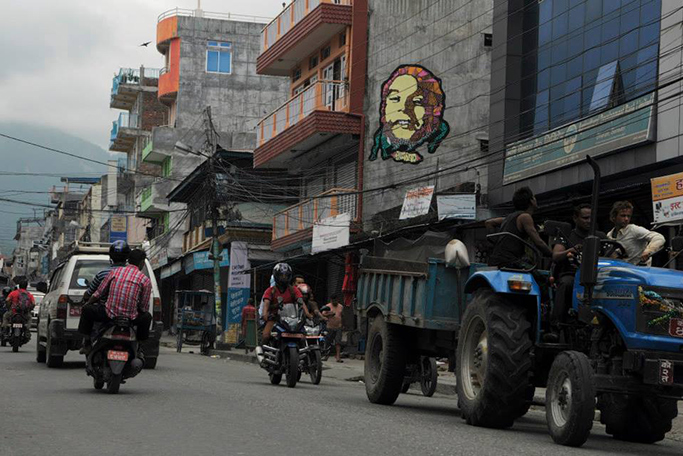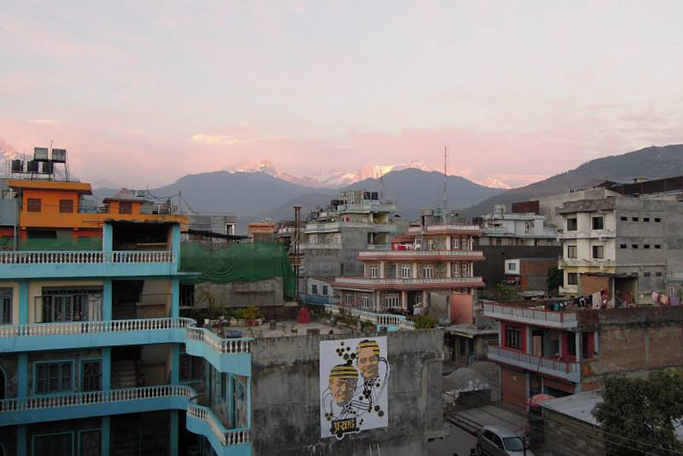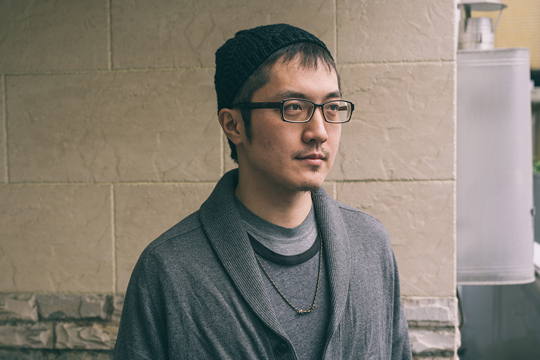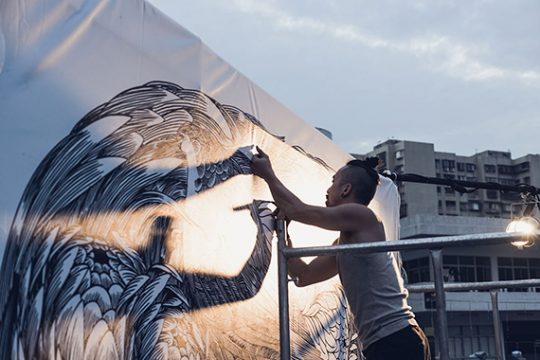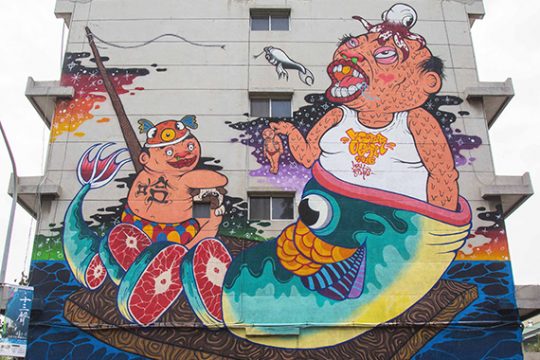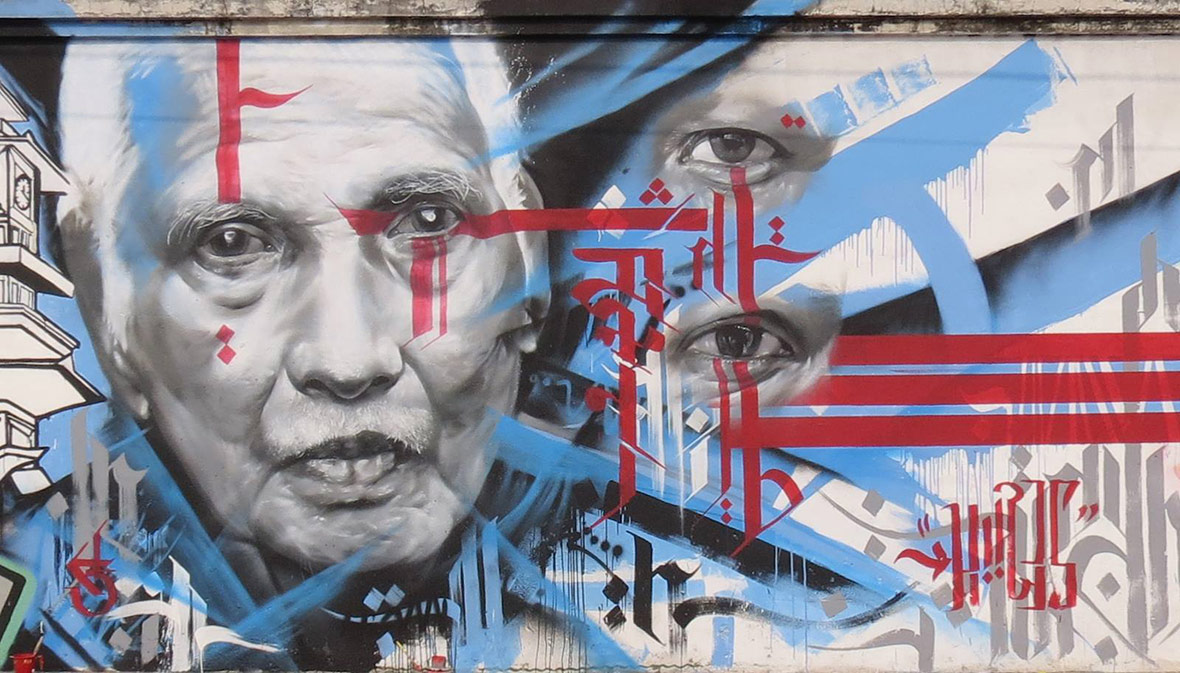
Kiran Maharjan (aka H11235) is a Nepalese artist who uses street art to address social issues within his community. Kiran is one of the primary organizers of the Prasad Project, a street art initiative to make a positive impact on Nepalese youth through workshops, exhibitions, and public murals.
Kiran Maharjan (又名H11235) 是一位力图用街头艺术解决他周遭社会问题的尼泊尔艺术家,也是Prasad项目,一个通过研习会、展览和公共壁画积极影响尼泊尔年轻一代的街头艺术联盟的最早组织者之一。
Neocha: How did you get into street art?
Kiran: I used to be influenced by classical European Realism, and I’ve always been intrigued by faces. I used to do portraits with charcoal and other mediums before I got into street art. Later on, I would be introduced to the graffiti and street art scene through skateboarding culture, especially the graphics on the skate decks.
I came to a turning point when I started to bring my works to commercial galleries in the city with the hope of being exhibited. All of them turned me down. Some considered me an amateur and didn’t want to showcase my work, while others turned me down because they simply weren’t interested in my style. This rejection became a driving force for me to use the streets as a medium for expression. That was four years ago, and since then I’ve always been active and present on the streets, continuing the process of growth and change.
Neocha: 你是如何涉足街头艺术领域的?
Kiran: 我曾深受古典的欧洲现实主义影响,并一直对人脸非常着迷。在涉足街头艺术之前,我就常用炭笔或其它工具绘制肖像。再之后,滑板文化,特别是滑板画,为我打开了涂鸦和街头艺术的大门。
人生转折点出现于我开始拿着自己的作品,带着可以出展的希望去那些商业画廊时。当时,他们全都拒绝了我。有些画廊认为我是新人而不想展出我的作品,而另一些则对我的作品毫无兴趣。那次的被拒,成为后来我选用街头作为表达媒介的一个驱动力。那已经是四年前的事了,自那之后,我就一直频繁走上街头,不停成长和蜕变。
Neocha: What is the Prasad Project about?
Kiran: The word “Prasad” is a Sanskrit term that means sweet offering that is given during prayers in a Hindu temple. We named our project after this because it’s our offering to the people through the medium of street art. Also, the first hero that we painted as a mural for our project, Laxmi Prasad Devkota, has the middle name “Prasad,” and that seemed fitting with our idea.
With this project, we hope to tackle one of the major contemporary problems being faced in our country: youth migration. Nepal has had a long history of political turmoil in addition to a worsening economic situation. A lot of our young people travel to the gulf and other countries to work as migrant workers in the hopes of a better life and income. Sadly, this has resulted in a brain drain in Nepal, and the bad living standards and unsafe working conditions abroad have only made the situation worse. Every day, the dead bodies of our migrant workers return back to Nepal.
Neocha: 能不能跟我们讲讲Prasad项目是什么?
Kiran: “Prasad”是一个梵文词,指印度教寺庙里分发给祷告者的甜祭。将这个名字定为项目名,是因为这项目也是我们通过街头艺术这个媒介献给人们的美好礼物。而且,我们为这个项目绘制的第一个壁画人物,Laxmi Prasad Devkota,中间名也是”Prasad”,这也正好契合了我们的主题。
通过这个项目,我们希望解决我们国家当今面临的一个重大问题: 青年流动。很长一段时间,除了经济不断恶化,尼泊尔还要面对政治动乱。许多年轻人为了更好的生活和收入,移居到了海湾地区和其它国家。遗憾的是,这直接导致了尼泊尔的人才严重流失,而他乡恶劣的生活条件和危险的工作环境更是让这种现状雪上加霜。每一天,我们都有在外打工者的尸体被送回尼泊尔。
Neocha: How does Prasad use street art to address the problem of youth migration in Nepal?
Kiran: The project tries to communicate that it’s possible for young people to be successful and to have a fulfilling life here in Nepal. One of our main themes is hometown heroes. Heroes are people who are born and raised in Nepal and have stayed here, making a difference in the country through their respective fields. Through their work, they’ve made a mark on the country, or even on the world. In order to commemorate them and inspire the youth, we paint public spaces with murals of these local heroes.
Since street art is a medium of the youth and so highly visible to the general public, it becomes a very powerful medium to talk about these issues. Street art is relatively new in Nepal, so it also spreads the message that with creative ideas, a DIY attitude, and new mediums of expression, it’s possible to solve our problems. We work with the youth directly, so it makes it easier to get this information out into the community.
Neocha: Prasad是如何用街头艺术为尼泊尔的青年流动问题进行呼吁呢?
Kiran: 这个项目力图传递一个信息,即,年轻人留在尼泊尔是有可能成功并过上充实生活的。我们的创作主题之一即是家乡英雄,那些土生土长、驻守着这片土地、通过各自的领域一点点改变着这个国家命运的尼泊尔人。他们,用他们的事业,将自己的印迹留在这片国土,甚至这个世界上。为了纪念他们并启发年轻人,我们在公共空间画上了这些本土英雄的壁画。
街头艺术是年轻人的表达方式,在公共场所也有极高眼球吸引力,所以它自然成为了探讨这类问题一个强有力的媒介。街头艺术在尼泊尔相对而言还算新事物,所以它也传递着富有创意的、满怀DIY姿态的、具有全新表达方式媒介的讯息。因此借由它来解决这些问题是可行的。我们与年轻人零距离接触工作,所以这让信息可以轻易传播到整个社群。
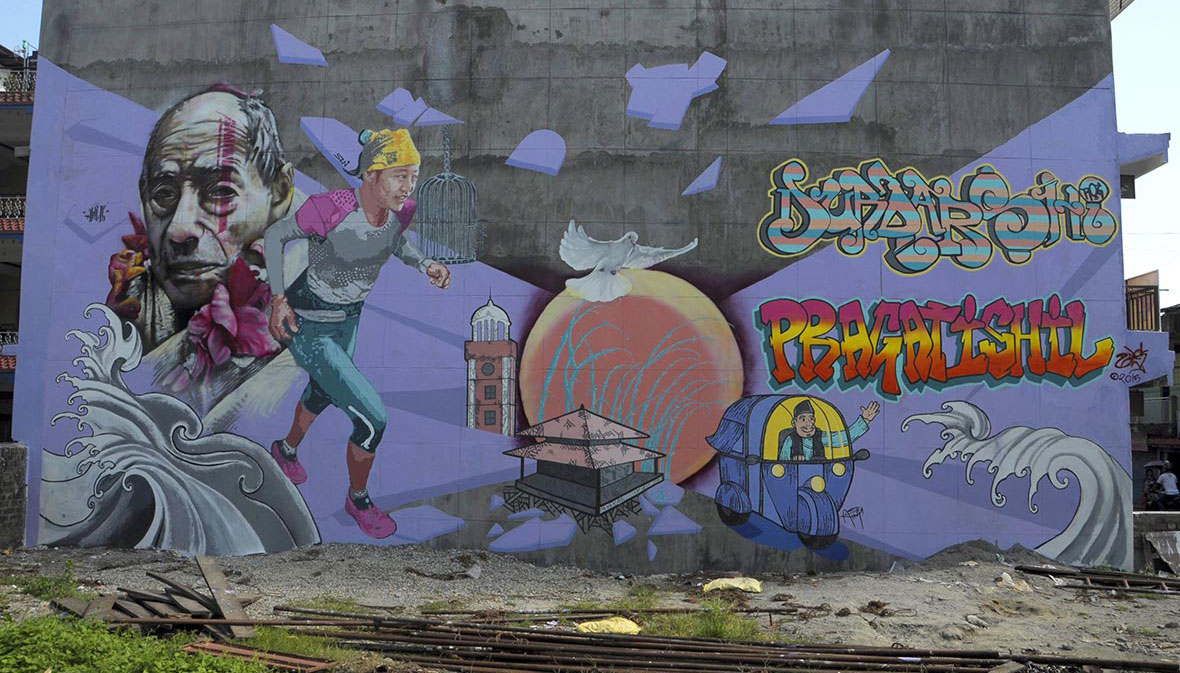
Neocha: What are the current and future plans for the Prasad Project?
Kiran: We’re now in the second phase of the Project, and we’ve continued to travel to different regions of the country in order to spread our message. In each city we visit, we conduct workshops with local youth to teach them street art, and we collaborate with them to paint two murals of local heroes. It’s a great way to take the skills that they’ve learned and try them out on the streets. It’s also a way for us to speak to the public about the project, as a lot of people come up and ask us questions regarding the work. Every mural is different and unique because it comes from the vibe of that specific city and its youth. In the end, the work belongs to them. It’s their city and their responsibility, so I think we need to make them understand that.
We plan to do this until the end of 2016, covering five more cities with street art, workshops and exhibitions. We hope to continue the project even after that with new initiatives.
Neocha: Prasad项目于当下以及未来有哪些计划?
Kiran: 我们目前处于这个项目的第二阶段,为了传播我们的理念,我们不停前往国内各个地区。在每个去过的城市,我们举办研习会,教当地青年街头艺术,我们也与他们合作绘制两幅当地英雄的壁画。这是让他们掌握并实践这些技能的最佳方式,也是我们向公众传播这个项目的一种途径,因为会有很多人上前对我们的作品进行询问。每一副壁画都是不同且独特的,因为它们都是来自各个城市和其年轻人群的特定环境。这些作品终是属于那些年轻人群。这是他们的城市,是他们的责任,我想我们需要让他们明白这一点。
我们打算2016年底之前都这么做,将我们的街头艺术、研习会和展览再覆盖五个城市。同时也希望之后能够带着新方案将整个项目延续下去。

